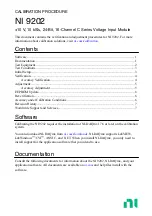
Section 5. System Overview
Memory for data can be increased with the addition of a
CF
(p. 510)
card and CF
storage module (connects to the
Peripheral
port) or a mass storage device (thumb
drive) that connects to
CS I/O
or both. See the appendix
Data-Storage Devices
— List
(p. 653)
for information on available memory expansion products.
By default, final-data memory (memory for stored data) is organized as ring
memory. When the ring is full, oldest data are overwritten by newest data. The
DataTable()
instruction, however, has an option to set a data table to
Fill and
Stop
.
5.3.9 Data Retrieval and Telecommunications — Overview
Related Topics:
•
Data Retrieval and Telecommunications — Quickstart
(p. 45)
•
Data Retrieval and Telecommunications — Overview
(p. 88)
•
Data Retrieval and Telecommunications — Details
(p. 391)
•
Data Retrieval and Telecommunication Peripherals — Lists
(p. 651)
Final data are written to tables in final-data memory. When retreived, data are
copied to PC files via a telecommunication link (
Data Retrieval and
Telecommunications — Details
(p. 391)
) or by transporting a CompactFlash
®
(CF)
card
(CRD: drive) or a Campbell Scientific mass storage media (USB: drive) to
the PC.
5.3.9.1 PakBus® Communications — Overview
Related Topics:
•
PakBus
®
Communications — Overview
(p. 88)
•
PakBus
®
Communications — Details
(p. 393)
•
PakBus
®
Communications — Instructions
(p. 584)
•
PakBus Networking Guide
(available at
www.campbellsci.com/manuals
http://www.campbellsci.com/manuals
The CR1000 communicates with
datalogger support software
(p. 654),
telecommunication peripherals
(p. 651),
and other
dataloggers
(p. 645)
with PakBus, a
proprietary network communication protocol. PakBus is a protocol similar in
concept to IP (Internet Protocol). By using signatured data packets, PakBus
increases the number of communication and networking options available to the
CR1000. Communication can occur via TCP/IP, on the
RS-232
port,
CS I/O
port, and
C
terminals.
Advantages of PakBus are as follows:
•
Simultaneous communication between the CR1000 and other devices.
•
Peer-to-peer communication — no PC required. Special CRBasic
instructions simplify transferring data between dataloggers for distributed
decision making or control.
•
Data consolidation — other PakBus dataloggers can be used as "sensors" to
consolidate all data into one CR1000.
•
Routing — the CR1000 can act as a router, passing on messages intended for
another Campbell Scientific datalogger. PakBus supports automatic route
detection and selection.
88
Summary of Contents for CR1000
Page 2: ......
Page 4: ......
Page 6: ......
Page 32: ......
Page 36: ......
Page 38: ......
Page 40: ......
Page 60: ...Section 4 System Quickstart Figure 16 PC200W View Line Graph 60 ...
Page 96: ......
Page 98: ...98 ...
Page 302: ......
Page 453: ...Section 8 Operation Figure 115 Using the Keyboard Display 453 ...
Page 456: ...Section 8 Operation Figure 118 Real Time Custom 456 ...
Page 457: ...Section 8 Operation 8 8 1 3 Final Memory Tables Figure 119 Final Memory Tables 457 ...
Page 458: ...Section 8 Operation 8 8 2 Run Stop Program Figure 120 Run Stop Program 458 ...
Page 460: ...Section 8 Operation Figure 122 File Edit 460 ...
Page 461: ...Section 8 Operation 8 8 4 PCCard Memory Card Display Figure 123 PCCard CF Card Display 461 ...
Page 478: ......
Page 506: ......
Page 536: ......
Page 636: ......
Page 642: ......
Page 644: ......
Page 676: ......
Page 677: ......
















































